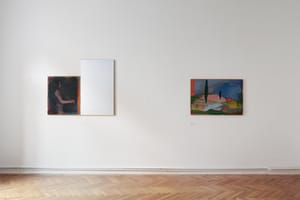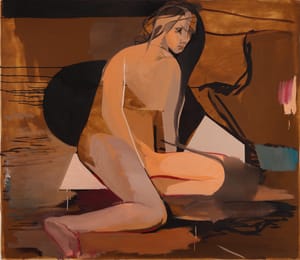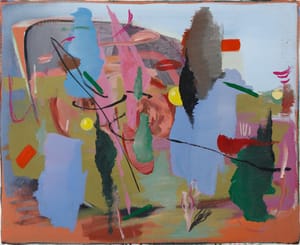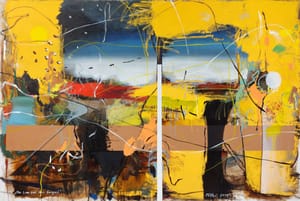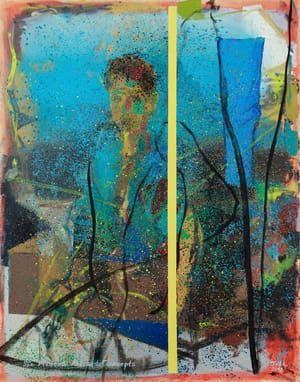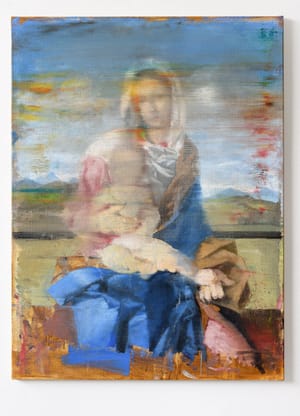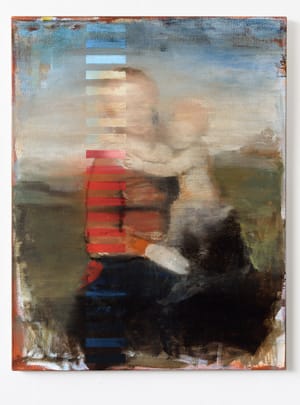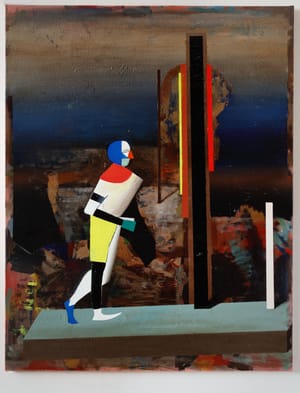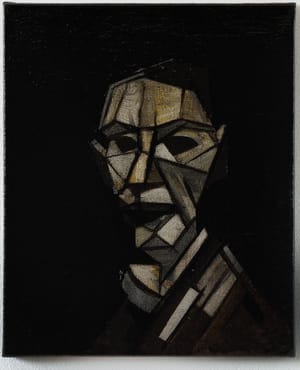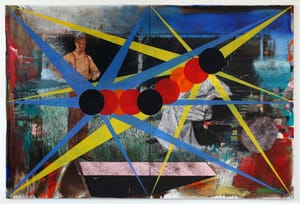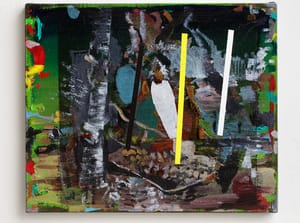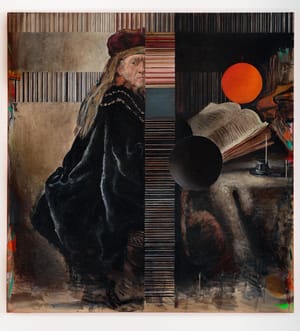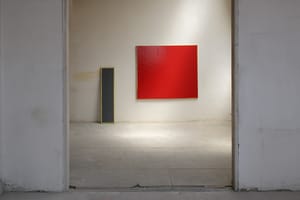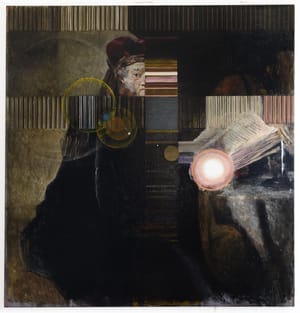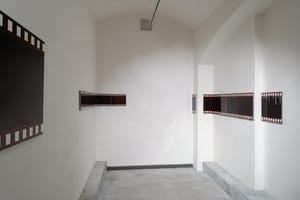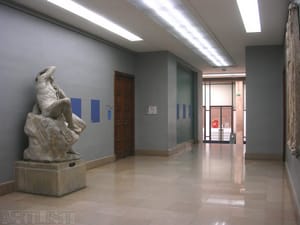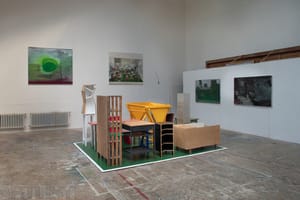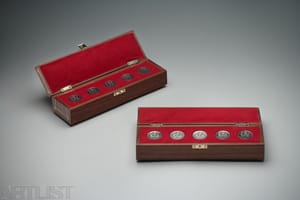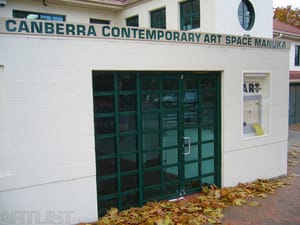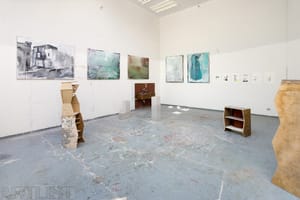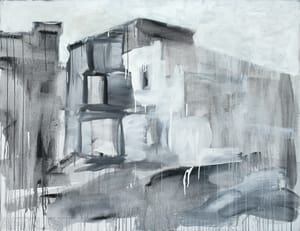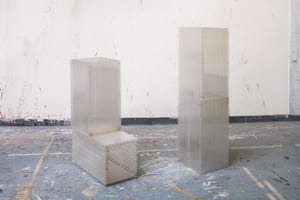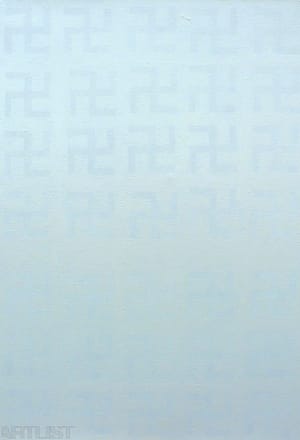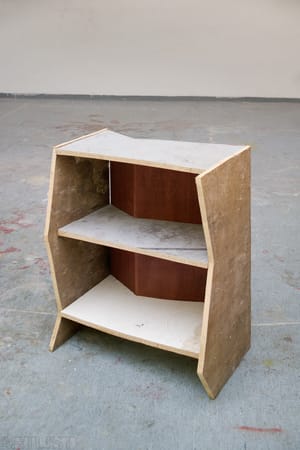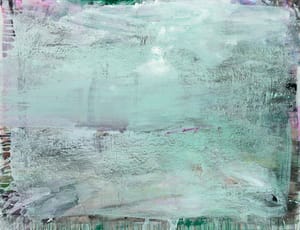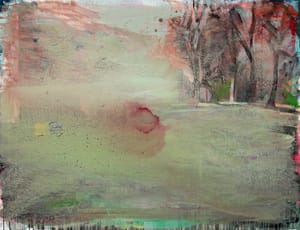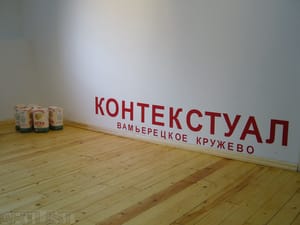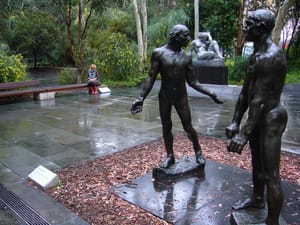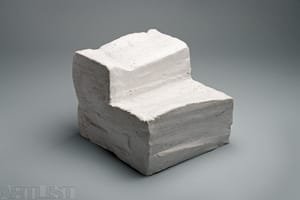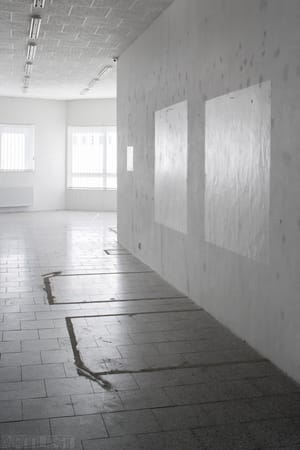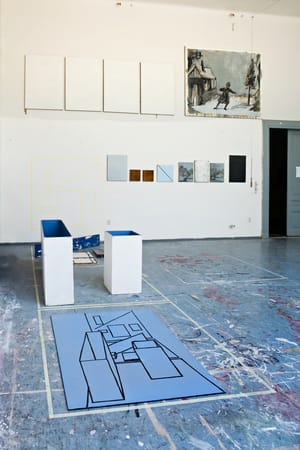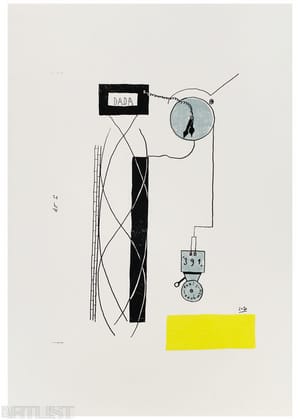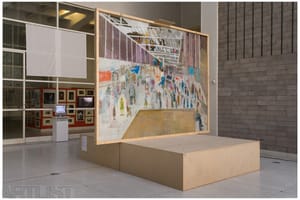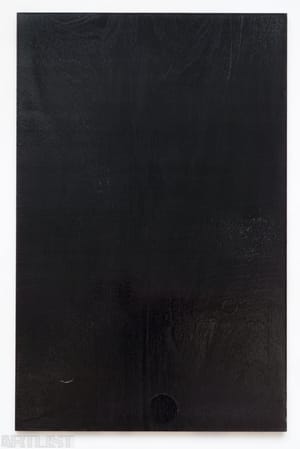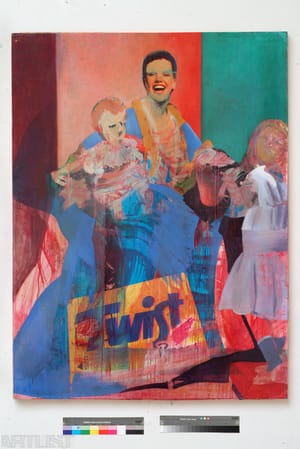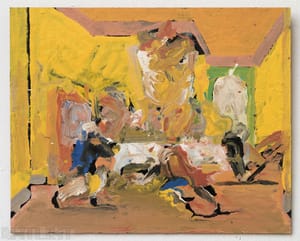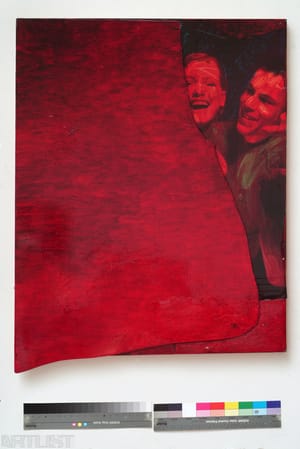- First Name
- Štefan
- Surname
- Tóth
- Born
- 1974
- Birth place
- Žatec
- Place of work
- Praha
- Website
- http://www.stefantoth.cz/
- CSU Library
- ↳ Find in the catalogue
About artist
Štefan Tóth both draws on and responds to the work of other artists. While a student at the Academy of Fine Arts in Prague, he already realised that appropriation would be his main concern. His interest is in the medium of painting, which he subjects to examination, attempting, through an almost scientific process, to get to the very roots of a work or its creator. He is interested in the quality of a work as an object, the value and psychology of colours and the history of genres, and he repeatedly returns to the question of what an image is still able to convey both in terms of form and content. He cites representatives of the current older generation as well as artists from past centuries. Whether it is Gerhard Richter, Salvator Rosa or Rembrandt, the interrelationships are always acknowledged in full and the series of works that results carries the name of the artist from whose work Tóth has drawn.
Exploring another’s work, thinking about it, and transforming it into another form has become a significant part of Tóth’s output. By creating compact series, imaginary chapters are created devoted to a specific personality or theme. He devotes himself with the same enthusiasm to the paraphrase of subject matter: gardens, bouquets or stripes, i.e. familiar motifs appropriated from other artists and rendered in his own inimitable style.
Although imitation is intrinsic to the history of art, in the case of Tóth it does not refer to a method of copying. He reflects upon the original artefact in the light of the new circumstances to which the work has been exposed since it was created, as well as to his own painting experience. The subsequent transfer of the original scene to a different context results in the creation of an authentic, new work. However, the artist himself regards this approach as temporary; it is important to him only until such time as he beings to work on his own “purely” authorial projects.
Tóth remains true to classical painting techniques such as oil on canvas and acrylic or watercolours on paper. He uses painting techniques even when his template is a photograph, as we see in the series After Jasanský Polák of 2008–2011. The original black-and-white images become large-scale paintings that in turn give the impression that they are original black-and-white photographs. Occasionally Tóth will draw on artists deploying even more modern approaches. And example would be the series from 2009 entitled After Ján Mančuška, in which he treats the work of an important representative of conceptual art as a visual installation with a legible tendency toward the medium of painting.
His interest in and relationship with considerations regarding the works of others and the transformation thereof is to be seen in the choice of subjects he opted to study. After graduating from Secondary School of Applied Arts, he studied at the Department of Alternative and Puppet Theatre at the Theatre Faculty of the Academy of Performing Arts (DAMU) in Prague. Though he had studied at DAMU and for many years had taken an interest in alternative and puppet theatre, Tóth continued to direct his main creative activities to the visual arts. The last year he spent at DAMU was also his first year at AVU. During this period of concurrent study, he confirmed that his own creative work, above all in the medium of painting, took priority for him.
Having spent two years studying with Professor Stretti, he transferred over to Milan Knížák. The transition to the Intermedia Studio meant coming a step closer to his own creative expression, his independence and his anchorage. He also completed an internship at the École nationale supérieure des Beaux-Arts in Paris under the supervision of Christian Boltanský. This world famous French artist, often classified as a conceptual artist, combines different techniques, influences and subject matter. An eclectic approach as a central component of his style is also a feature of Tóth’s oeuvre.
In addition to his own art, Tóth also engages in other, artistically related professions. He is aware of the importance of the observer, i.e. the recipient of the work of art, and so while still a student decided to engage actively with art from the position of exhibition organiser, theorist and critic. For almost five years he worked with the Prague private gallery DeaOrh, where he occupied all the positions referred to. Since 2017 he has been the collection administrator at the Kunsthalle Prague. Štefan Tóth’s work is to be found in the National Gallery in Prague, the Yvon Lambert Collection, and, for instance, in the private collection of the Zemans.
- Author of the annotation
- Michaela Banzetová
- Published
- 2020
CV
Vzdělání 2008–2012
Akademie výtvarných umění v Praze, Intermediální škola Milana Knížáka (Ph.D.) 2007
École nationale supérieure des beaux-arts, Paříž (Christian Boltanski) 2001–2007
Akademie výtvarných umění v Praze, restaurátorský ateliér Karla Strettiho a Intermediální škola Milana Knížáka 1998–2002
Divadelní fakulta Akademie múzických umění, scénografie ALD (Petr Matásek, Pavel Kalfus) 1995–1996
Vyšší odborná škola uměleckoprůmyslová v Praze 1991–1995
Střední uměleckoprůmyslová škola v Praze 1989–1991
Střední průmyslová škola elektrotechnická v Praze Ocenění, rezidence a stipendia
2015
Miami meets Milano Prize, Biennale Milano, Milano 2009
finalista Leinemann-Stiftung für Bildung und Kunst, Berlín 2008
finalista NG 333 & CEZ Group Prize, Národní galerie v Praze
Tvůrčí stipendium, Ministerstvo kultury České republiky, Praha 2007
finalista, NG 333 & CEZ Group Prize, Národní galerie v Praze
École nationale supérieure des beaux-arts, Paris, Christian Boltanski (stipendium) 2006
Louis Vuitton Moët Hennessy Prize, Paříž 2005
Barceló Prize, Barceló Foundation, Mallorca
- Member of art groups not included in ARTLIST.
- 2005–2007 KONTEXTUAL od 2008 NEUE KONTEXTUAL
Exhibitions
- Solo exhibitions
-
2019
Štefan Tóth, 1st Floor Gallery, Praha
2018
Holistic Principle, Garage Gallery Karlin, Praha
2016
Monochromy, Stefan Toth Studio, Praha
Adozione, Bim Gallery, Dobřichovice, Czech Republic
2014
After Rembrandt, Národní galerie v Praze (Šternberský palác), Praha
2014
Et in Arcadia ego/Retroactive Renaissance-After Pietro Bembo, Dea Orh Gallery, Praha
2013
Kunst ist nicht das Konzeptuelle, Kunst ist das Kontextuell, La Brique Gallery, Frankfurt
2012
Garden Series, Dea Orh Gallery, Praha
Prints 2005-2012, Oblastní galerie Vysočiny v Jihlavě
2011
After Jasansky/Polak, Galerie České pojišťovny, Praha
2010
What is important is what you can’t see, Dea Orh Gallery, Praha (s P. Tichoňem)
2008
Der Spielplatz, Michal’s Collection Gallery, Praha
Appropriation II., Galerie Jelení, Praha
2007
Kontextual: Participation Method No. 2, Modern Gallery AVU, Praha
Le Photo, Fondation Victor Lyon, Paris
Le Monochrome, École nationale supérieure des beaux-arts, Paris
2006
Kontextual: Optimum Portrait, Embassy of the Czech Republic, Canberra, Australia
Kontextual: Intuition No. 1, ANU School of Art Gallery, Canberra, Australia
Kontextual: Intuition No. 1, C2C Gallery, Praha
Kontextual: Seated Figure, Sculpture’s Garden, National Gallery of Australia
Kontextual: Double Salchow, XXL Gallery, Louny, Česká republika
2005
Kontextual: Portrait of Sicilian Squire with Puppets, AVU Gallery, Praha
Type A-Type B, Villa Pelle, Praha
1996
Czech Landscape, SUPS Gallery, Praha (s D. Kouteckým)
- Group exhibitions not included in ARTLIST.
-
2017
6th visit of the Collection Eva and Petr Zeman, Galerie Sladovna, Žatec
2016
Spoleto Arte, Palazzo Leti Sansi, Spoleto
Viva Charles IV., St. Luke’s Church, Svárov
2015
Miami meets Milano, Hotel Victor, Miami Beach, Florida, USA
Spoleto Arte incontra Venezia, Palazzo Giustinian, Venice
Biennale Milano: International Art Meeting, Milano Art Gallery, Milan
2013
Personal Structures, Palazzo Bembo, 55. Biennale di Venezia, Italy
2011
Square: Studio of prof. Milan Knizak, Lalit Kala Akademi, New Delhi, India
Juraj Kollar, Tomas Nemec, Adam Stech, Stefan Toth, Dea Orh Gallery, Praha
Original & Perspective, Bohemian Modern Art Gallery, Praha
Studio of prof. Milan Knizak, UFFO Gallery, Trutnov, Česká galerie
2010 I believe in Miracles. 10th Anniversary of the Lambert Collection,
Collection Lambert, Avignon
2009
FIVE, Dea Orh Gallery, Praha
Those? Theme! Sam83 Gallery, Česká Bříza, Česká republika
19 years after, Embassy of the Czech Republic, Berlin
2008
Výstava finalistů ceny NG 333 & CEZ Group Award, Národní galerie, Veletržní Palác, Praha
Centre of Contemporary Art Ládví, Experimental venue Roxy/NoD, Praha
Re-Reading The Future, International Triennale of Contemporary Art 2008, Národní galerie, Veletržní Palác, Praha
Fresh relationships, Art Factory Gallery, Praha
2007
Výstava finalistů ceny NG 333 & CEZ Group Award, Národní galerie, Veletržní Palác, Praha
AVU 18, Národní galerie Veletržní Palác, Praha
Studio of prof. Milan Knizak, Cairo Opera House, Cairo, Egypt
Diplomanti AVU, Akademie výtvarných uměí, Praha
In our Africa, Chateau Moravska Trebova, Moravska Trebova, Czech Republic
Chapel, AVU Gallery, Prague
Towards the Shiny Tomorrows, City Gallery Svitavy, Svitavy, Czech Republic
Chaplin Resident Fighter, Galerie Futura, Praha
2006
International Painting Salon, Carbunari 2006, Baia Mare, Romania
Art is nothing, Cultural Center DOM, Moscow, Russia
Sculpture Grande 2006, Art Factory Gallery, Praha
Exhibition of the Winners of the LVMH Award, Association Le Pont Neuf, Paris
No Scrube, Canberra Contemporary Art Space Manuka, Australia
Artkontakt, Galerie Nova síň, Praha
Kontextual: Optimum Portrait, Multiplace festival, C2C Gallery, Praha
Artkontakt, Galerie ARSkontakt, Brno, Česká republika
2005
Studio prof. Milana Knížáka, Gaudeamus Gallery, Ostrava, Česká republika
Exhibition of the Finalists of the Barceló Award, Hotel Barceló, Praha
La petite mort, Městská galerie Slavonice, Slavonice, Česká republika
Czech Picture Today, International Biennale of Contemporary Art 2005, Národní galerie, Veletržní Palác, Praha
Studio prof. Milana Knížáka, Art Factory Gallery, Praha
Studio prof. Milana Knížáka, XXL Gallery, Louny, Česká republika
Design Studies of prof. Otto Wichterle‘s Monument, Institutu makromolekulární chemie, Praha
2004
Prague International Art Fair, Municipal House, Praha
Cialis, Ledebur’s Terase, Praha
1999
Cube, Prague Quadrennial 1999, 9th International Exhibition of Stage Design
and Theatre Architecture, Section of Schools, Praha
1995
Portréty, Zámecká galerie, Zámek Jemniště
1994
Lord’s supper, Zámecká galerie, Zámek Jemniště
Tolerance, International Symposium of Youth Art, Altkirch
- Collections
- Národní galerie v Praze National Gallery of Australia in Canberra, Austrálie Collection Yvon Lambert, Avignon, Francie Barceló Foundation, Mallorca, Španělsko Eva and Petr Zeman Collection, Praha Kunsthalle Praha, Praha Soukromé sbírky v České republice, Francii, SRN, Rumunsku, Rusku, Austrálii a USA
- Other realisations
Performance a projekty: 2015
Vaclav Havel: Anticodes, The Vaclav Havel Library Foundation, Praha
2007
Kinimod Gnal/Kontextual group, Galerie Svitavy, Svitavy, Česká republika
2006
Chaplin Resident Fighter/Kontextual group, Galerie Futura, Praha
2005
The Concept and Perception/Kontextual group,
International Biennale of Contemporary Art 2005, Národní galerie v Praze
2002
Don Quixote, Studio Damuza Theatre, Praha
1999
Poezie v metru, 4+4 dny v pohybu, Hala ČKD Karlín, Praha
Příběh Krychle, Pražské Quadriennale 1999, 9. mezinárodní výstava scénografie a divadelní architektury, Praha
1994
Tolerance, International Symposium of Youth Art, Altkirch
Kurátorské realizace: 2015
Jacques Papi: Corsican Abstractions, Adolf Loos Apartment and Gallery-Manes, Praha
2013
Braco Dimitrijevic: New Culturescapes, Dea Orh Gallery, Praha
Erik Sille: fire walk with me, Dea Orh Gallery, Praha
Jan Vasilko: To my Dear Citizens of Prague, Dea Orh Gallery, Praha
Vladimír Vela, Dea Orh Gallery, Praha
2009
FIVE, Dea Orh Gallery, Praha
Monography
- Monography
Monografie a katalogy samostatných výstav 2019After Pietro Bembo. Text: Štefan Tóth. Pavel Tichoň – Individuum, Praha 2011
Štefan Tóth: After Jasansky/Polak. Text: Petr Vanous. Rozhovor s Petrem Vaňousem. Dea Orh Gallery and PPF Art, Praha
Stefan Tóth. Text: Milan Knížák. Dea Orh Gallery, Praha 2010
Štefan Tóth: What is important is what you can’t see. Text: Petr Vaňous. Houdek Publishing, Praha Katalogy společných výstav, publikace 2017
6th visit of the Collection Eva and Petr Zeman. Texts by Zdenka Hamousova, Jan Samec, Eva and Petr Zeman. Renesanční Galerie Sladovna, Žatec 2016
Nearly-Textbook: 25 Years of the First Czechoslovak Intermedial School.
Text by Milan Knizak, Milan Peric, Students of Studio, Archive of Studio.
Smira-Print Publishing a Akademie výtvarných umění, Praha 2015
Rembrandt and his Scholar. Texts by Jitka Handlova and Jana Klimova. Národní galerie Praha
Biennale Milano-International Art Meeting. Texts by Francesco Alberoni, Mauro Corona, Cristiano De André, Gian Luca Galletti, Roberto Maroni, Salvo Nugnes, Giuliano Pisapia, Katia Ricciarelli and Vittorio Sgarbi. Promoter Arte, Milan 2014
Zemkovy plenéry. Text: Milan Knížák, Nadace Moravské Slovacko, Veselí nad Moravou 2013
Personal Structures. Editor Global Art Affairs Foundation. Global Art Affairs Foundation & Global Art Center Foundation, Leiden/Venice (exh. cat.) 2012
Nah Dahinter. Texts by Hans Schiffling and Hana Sauerova. Pro Arte Vivendi, Praha 2011
Original & Perspective. Text by Rea Michalova. Bohemian Modern Art Gallery, Praha 2010
Jelení Gallery 1999-2009, Texts by David Adamec et al. Centrum pro současné umění Praha 2009
909: Art from the Turn of the Millennium in The National Gallery in Prague Collections 1990-2009. Edited by Milan Knížák and Tomas Vlček. Národní galerie Praha FIVE. Text by Stefan Toth. Dea Orh Gallery, Praha (exh. cat.) KUNSTPREIS 2009. Texts by Ralf Leinemann, Natascha Driever and Josef Bares. Leinemann-Stiftung für Bildung und Kunst, Hamburg/Berlin 2008
NG 333 & CEZ Group Award. Texts by Roman Franta, Martin Kana, Milan Knizak, Alena Kupcikova, Alexandra Kusa, Neue Kontextual Group, Ivona Raimanova, Jan Synek, Lucie Siklova, Barbora Ticha, Petr Vanous, Tomas Vlcek and Vlasta Zakova. Národní galerie Praha (exh. cat.) Re-Reading the Future: International Triennial of Contemporary Art 2008. Edited by Ivan Hartmann, Svetlana Michajlova and Katarina Rybkova. Kant Publishing a Národní galerie Praha (exh. cat.) 2007
NG 333 & CEZ Group Award. Texts by George Hladik, Milan Knizak, Kontextual group, Lenka Sedlackova, Pawell Tichon, Tomas Vlcek and Ztohoven group. Národní galerie Praha (exh. cat.) AVU 18. Texts by Jiri Prihoda and Vladimir Skrepl. Akademie výtvarných umění, Praha (exh. cat.) Diplomanti AVU 2007. Text Milena Slavicka. Akademie výtvarných umění, Praha (exh. cat.) 2005
International Biennale of Contemporary Art 2005. Edited by Ivan Hartmann, Svetlana Michajlova a Katarina Rybkova. Národní galerie, Praha (exh. cat.)
- Articles
2011
Kateřina Tučková: Tothovy malířské parafráze, in: Art & Antique, October
Mimi Fronczak Rogers: Tóth’s labor-intensive appropriation of Jasanský/Polák photos, in: The Prague Post, September
